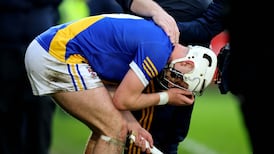The hurling league can leave you a bit like an eejit at the fairground. You know the three-card trick man has his eye on you but then again, it might just be possible to keep an eye on what he’s doing with his hands.
Yet again the winners and losers from the opening weekend in Division One A were reversed – apart from poor old Cork who went down to a second defeat and holders Waterford who now top the table with two wins.
Nowlan Park was the most interesting tussle of the weekend. Kilkenny had been, on their own admission, rusty against Waterford and lucky not to lose by a lot more than four points given their hosts’ experimentation with variety in the shooting of wides. Tipp were as mentioned above energetic and far bouncier than the All-Ireland champions had looked.
There is however a dynamic that governs recent matches between the counties and that is, Kilkenny nearly always win. Since Tipperary’s All-Ireland win in 2010 there have been 13 competitive (league and championship) matches between the counties and Tipp have won just two, with 10 defeats and one draw.
New contender
Extending that sequence last Sunday with a late smash-and grab was achieved while at the same time showcasing some promising new contenders for team places, including
TG4
Man of the Match
James Maher
.
The most remarkable aspect of Kilkenny in the Brian Cody era has been the sustained high pitch at which they've operated and the consistency of the team's competitiveness.
This has been most striking in the past couple of years, as one by one the genuinely legendary figures, who had contributed so much to the glut of success enjoyed in the past decade, departed the big stage.
Still the county has been able to lay claim to arguably the best hurlers in the contemporary game in TJ Reid and Richie Hogan, who have been awarded the two most recent Hurler of the Year awards.
The ability to regenerate while losing outstanding players is an extraordinary one in a county with a small population.
A significant factor in this process of renewal is that there is no down time for Kilkenny teams. Poor performances are never allowed to become a trend despite it being perfectly plausible that a team winning so much during the summer might want to go down the gears during a league campaign.
During conversation with a Kilkenny official before last Sunday’s match it was said that the county has a bottom line for league involvement and that is for the team to reach one final in every three. That’s for funding purposes – the allocations to counties that go the distance are obviously the greatest available.
Players are aware of that but if the pressure to save the county board from penury is oppressive, you’d never know it from the regularity with which they hit – and generally exceed – that target.
In the 17 seasons of Cody’s management Kilkenny have won eight titles and reached two further finals. So that’s a strike rate of 1.7 – or nearly twice the required frequency. Clearly there is a greater urgency to do well in the league than simply the need to sell tickets.
It is detectable throughout Cody’s years in charge. He never diminishes the competition – by for instance running the old ‘the league isn’t a priority for us this year’ line – and appears constantly interested in winning it.
And for good reason. During the 17 completed seasons of his management to date, Kilkenny have failed to achieve qualification for the next phase on only three occasions.
Last year came with the alibis that the Ballyhale Shamrocks players weren’t available for nearly all of the campaign – Kilkenny haven’t won the league in any of the three years during the last 10 in which Ballyhale were winning All-Irelands – and injury problems. Once all was restored the county won the All-Ireland.
The other two years, failing to reach phase two in 2004 and finishing fourth in 2010 when the format paired the two counties at the top of table in the league final, ended in All-Ireland disappointment.
There is a strong connection between the consistent level of spring attainment and the 11 bountiful harvests that have been gathered in the past 16 Septembers.
Young or developing players are always going to stand a better chance of fulfilling their potential being introduced in small numbers into an already successful team. Furthermore the environment becomes a lot more reliable as a metric if everyone knows that these matches matter and will be treated as excuse-free zones.
Legendary careers
The corollary of this is that players who perform generally keep their places. Back in 2002 on the way to his first league title Cody retained a number of young players who had been introduced during the league and they were still there for that year’s All-Ireland final.
As legendary careers unfolded some players were always going to get their place back as soon as injuries cleared but fresh talent would ultimately trump a back-catalogue, however storied. That’s why so many great players retired on the bench. Nothing is ever taken for granted. If the prevailing ethos is Spartan there is also stoicism. County chair Ned Quinn said last week: “We know what we’ve been doing isn’t going to carry on forever and we’ll have a fallow period.”
Other counties might be sceptical.
smoran@irishtimes.com











